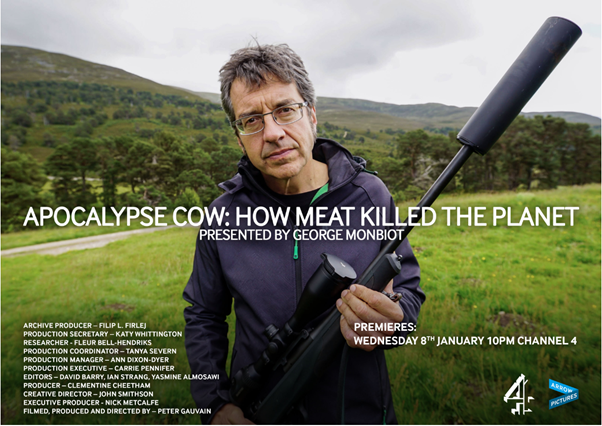
The writings of ‘The Guardian’ columnist George Monbiot (‘George’) over the last few years have become more radical when it comes to the future of agriculture. This took my (and many others) notice when in 2014 George released an article questioning the evidence for some of Allan Savory’s claims in his famed TED talk and following the inaugural Savory Institute Conference in London (UK) that year. This led to a vigorous round of exchanges and debates including this article by L. Hunter Lovins, renowned environmentalist and co-author of ‘Natural Capitalism‘.
In January of 2020 Britain’s Channel 4 screened a short documentary presented by George titled, ‘Apocalypse Cow: How Meat Killed the Planet‘. We were able to watch this on YouTube over the weekend.
I happen to agree with a lot that George points out in this documentary, however there is a lot that I do not and so I felt it was necessary to provide a response to it based on the context of the work and experience of myself and the Regrarians Workplace membership.
Rather than directly deal with the specifics of the entire documentary I have listed the following talking points in response:
1. Agriculture as both a land-use and cornerstone of civilisation has in large part been an ecological disaster for this planet.
2. Unfortunately there are very few examples that we could take George to where agricultural ecologies provide levels of biodiversity and ecosystem function that are close to what their pre-agricultural state might have been.
There are even fewer agroecologies where there has been a sufficiently longitudinal body of monitoring to provide evidence of their performance. There are certainly systems where elements of their function and biodiversity are very high and increasing but naturally very different to their pre-agriculture state.
3. Agriculture as an industry right now has producers suffering at the hand of appalling terms of trade. Would a return of better terms of trade mean that producers would become better land managers or would they apply these funds elsewhere is another matter.
4. According to the Savory Brittleness Scale, those landscapes on the brittle side of that scale will have often face reduced landscape function and biodiversity as a function of rest from herbivores. It appears that this documentary was created for a UK/Republic of Ireland audience, however as many in the world will watch this, George needs to make that point and distinction as he broadly strives to make the case for re-wilding across the planet. The places in the film that he highlights are in non-brittle landscapes and to have them revegetate is a comparatively simple matter — by applying prolonged rest. As for their complete re-wilding that is whole other matter.
5. Ecosystems all over the world are suffering for a lack of their previously full suite of trophic components and to re-introduce them is filled with all manner of issues — particularly when it comes to the re-introduction of keystone predators — extinction of many of these species makes re-wilding to a pre-Anthropocene state impossible, hence the call by some to use analogue species in their place.
6. Most Regrarians Members and regenerative agriculture/agroecology practitioners would understand that there is an ideal and then there is the problem of paying for the pathway to that ideal and populating/keeping enough people in a landscape to sustain that.
7. Laboratory-produced industrial feedstocks already exist as do extremely simplified broadscale production systems. As agriculture is increasingly a business that feeds humans who are within what I call the ‘urban/suburban feedlot’, the continued trajectory towards the further expansion (and concentration) of these value chains is likely.
8. A parallel value chain (that many Regrarians Members are involved within) will continue to also exist, expand and (hopefully) decentralise.
9. How many consumers are prepared to manage their lifestyles and spending decisions to support agricultural producers who will prove George wrong?
10. How many agricultural producers would choose to direct the proceeds of improved terms of trade towards increasing their natural capital? And therefore how many would change to agricultural practices that increase biodiversity and landscape function such that off-farm effects are positive.
11. Core points of likely disruption are both obvious and of course many are yet to emerge.
12. Agriculture has long been a cradle of innovation and where it’s producers are appropriately supported and incentivised, especially through outcome-based verification, we are already bearing witness to an agroecological future that is just that — ecological and therefore thermodynamically efficient.
